Shaping Phenolic Resin-Coated ZIF-67 to Millimeter-Scale Co/N Carbon Beads for Efficient Peroxymonosulfate Activation
Abstract
:1. Introduction
2. Results
2.1. Characterizations
2.2. Catalytic Performance
2.3. Effects of pH on TC Degradation
2.4. Effects of Temperature on TC Degradation
2.5. Effect of Anions and Organic Matter
2.6. Degradation Mechanism
2.7. Recyclability and Stability
3. Materials and Methods
3.1. Reagents
3.2. Preparation of Porous Carbon Beads
3.3. Characterization
3.4. Catalytic Experiments
4. Environmental Challenges, Industrialized Capabilities, and Future Considerations
5. Conclusions
Supplementary Materials
Author Contributions
Funding
Institutional Review Board Statement
Informed Consent Statement
Data Availability Statement
Conflicts of Interest
References
- Xu, L.Y.; Zhang, H.; Xiong, P.; Zhu, Q.Q.; Liao, C.Y.; Jiang, G.B. Occurrence, fate, and risk assessment of typical tetracycline antibiotics in the aquatic environment: A review. Sci. Total Environ. 2021, 753, 141975. [Google Scholar] [CrossRef] [PubMed]
- Tian, X.D.; Lin, Y.; Gong, Y.R.; Zhang, G.Z.; Wang, Y.; Yang, W.T.; Su, Z.M. Facile synthesis of MIL-88A/PVA sponge for rapid tetracycline antibiotics degradation via sulfate radical-advanced oxidation processes. Sep. Purif. Technol. 2024, 351, 128122. [Google Scholar] [CrossRef]
- Gan, Z.Y.; Hu, X.T.; Xu, X.C.; Zhang, W.; Zou, X.B.; Shi, J.Y.; Zheng, K.Y.; Arslan, M. A portable test strip based on fluorescent europium-based metal-organic framework for rapid and visual detection of tetracycline in food samples. Food Chem. 2021, 354, 129501. [Google Scholar] [CrossRef]
- Dai, Y.J.; Liu, M.; Li, J.J.; Yang, S.S.; Sun, Y.; Sun, Q.Y.; Wang, W.S.; Lu, L.; Zhang, K.X.; Xu, J.Y.; et al. A review on pollution situation and treatment methods of tetracycline in groundwater. Sep. Sci. Technol. 2020, 55, 1005–1021. [Google Scholar] [CrossRef]
- Chen, X.L.; Yang, Y.Y.; Ke, Y.C.; Chen, C.; Xie, S.G. A comprehensive review on biodegradation of tetracyclines: Current research progress and prospect. Sci. Total Environ. 2022, 814, 152852. [Google Scholar] [CrossRef] [PubMed]
- Chen, Y.C.; Liu, J.T.; Zeng, Q.B.; Liang, Z.X.; Ye, X.X.; Lv, Y.C.; Liu, M.H. Preparation of Eucommia ulmoides lignin-based high-performance biochar containing sulfonic group: Synergistic pyrolysis mechanism and tetracycline hydrochloride adsorption. Bioresour. Technol. 2021, 329, 124856. [Google Scholar] [CrossRef] [PubMed]
- Hu, P.; Shao, J.Y.; Qian, G.S.; Adeleye, S.A.; Hao, T.W. Removal of tetracycline by aerobic granular sludge from marine aquaculture wastewater: A molecular dynamics investigation. Bioresour. Technol. 2022, 355, 127286. [Google Scholar] [CrossRef]
- Liu, W.B.; Zhou, J.B.; Liu, D.; Liu, S.; Liu, X.J.; Xiao, S. Enhancing electronic transfer by magnetic iron materials and metal-organic framework via heterogeneous Fenton-like process and photocatalysis. Mater. Sci. Semicond. Process 2021, 135, 106096. [Google Scholar] [CrossRef]
- Heris, S.Z.; Etemadi, M.; Mousavi, S.B.; Mohammadpourfard, M.; Ramavandi, B. Preparation and characterizations of TiO2/ZnO nanohybrid and its application in photocatalytic degradation of tetracycline in wastewater. J. Photochem. Photobiol. A-Chem. 2023, 443, 19. [Google Scholar]
- Wang, D.B.; Jia, F.Y.; Wang, H.; Chen, F.; Fang, Y.; Dong, W.B.; Zeng, G.M.; Li, X.M.; Yang, Q.; Yuan, X.Z. Simultaneously efficient adsorption and photocatalytic degradation of tetracycline by Fe-based MOFs. J. Colloid Interface Sci. 2018, 519, 273–284. [Google Scholar] [CrossRef]
- Yan, X.; Yao, Y.Y.; Zhang, H.; Xie, J.; Xiao, C.M.; Zhang, S.; Qi, J.W.; Sun, X.Y.; Li, J.S. Zeolitic imidazolate framework (ZIF-8)/polyacrylonitrile derived millimeter-sized hierarchical porous carbon beads for peroxymonosulfate catalysis. Environ. Res. 2022, 206, 112618. [Google Scholar] [CrossRef] [PubMed]
- Ashrafivala, M.; Mousavi, S.B.; Heris, S.Z.; Heidari, M.; Mohammadpourfard, M.; Aslani, H. Investigation of H2O2/UV advanced oxidation process on the removal rate of coliforms from the industrial effluent: A pilot-scale study. Int. J. Hydrog. Energy 2022, 47, 33530–33540. [Google Scholar] [CrossRef]
- Cao, J.Y.; Lai, L.D.; Lai, B.; Yao, G.; Chen, X.; Song, L.P. Degradation of tetracycline by peroxymonosulfate activated with zero-valent iron: Performance, intermediates, toxicity and mechanism. Chem. Eng. J. 2019, 364, 45–56. [Google Scholar] [CrossRef]
- Duan, X.G.; Su, C.; Miao, J.; Zhong, Y.J.; Shao, Z.P.; Wang, S.B.; Sun, H.Q. Insights into perovskite-catalyzed peroxymonosulfate activation: Maneuverable cobalt sites for promoted evolution of sulfate radicals. Appl. Catal. B-Environ. 2018, 220, 626–634. [Google Scholar] [CrossRef]
- Zhang, M.; Xiao, C.M.; Yan, X.; Chen, S.S.; Wang, C.H.; Luo, R.; Qi, J.W.; Sun, X.Y.; Wang, L.J.; Li, J.S. Efficient Removal of Organic Pollutants by Metal-organic Framework Derived Co/C Yolk-Shell Nanoreactors: Size-Exclusion and Confinement Effect. Environ. Sci. Technol. 2020, 54, 10289–10300. [Google Scholar] [CrossRef] [PubMed]
- Mitrovic, J.; Vucic, M.R.; Kostic, M.; Velinov, N.; Najdanovic, S.; Bojic, D.; Bojic, A. Sulfate radical-based degradation of antraquinone textile dye in a plug flow photoreactor. J. Serb. Chem. Soc. 2019, 84, 1041–1054. [Google Scholar] [CrossRef]
- Yu, D.B.; Song, Q.J.; Cui, J.W.; Zheng, H.M.; Zhang, Y.; Liu, J.Q.; Lv, J.; Xu, T.W.; Wu, Y.C. Designing core-shell metal-organic framework hybrids: Toward high-efficiency electrochemical potassium storage. J. Mater. Chem. A 2021, 9, 26181–26188. [Google Scholar] [CrossRef]
- Marpaung, F.; Kim, M.; Khan, J.H.; Konstantinov, K.; Yamauchi, Y.; Hossain, M.S.A.; Na, J.; Kim, J. Metal-Organic Framework (MOF)-Derived Nanoporous Carbon Materials. Chem.-Asian J. 2019, 14, 1331–1343. [Google Scholar] [CrossRef]
- Wang, H.F.; Chen, L.Y.; Pang, H.; Kaskel, S.; Xu, Q. MOF-derived electrocatalysts for oxygen reduction, oxygen evolution and hydrogen evolution reactions. Chem. Soc. Rev. 2020, 49, 1414–1448. [Google Scholar] [CrossRef]
- Gogoi, N.; Chowdhury, D. Novel carbon dot coated alginate beads with superior stability, swelling and pH responsive drug delivery. J. Mat. Chem. B 2014, 2, 4089–4099. [Google Scholar] [CrossRef]
- Krüner, B.; Schreiber, A.; Tolosa, A.; Quade, A.; Badaczewski, F.; Pfaff, T.; Smarsly, B.M.; Presser, V. Nitrogen-containing novolac-derived carbon beads as electrode material for supercapacitors. Carbon 2018, 132, 220–231. [Google Scholar] [CrossRef]
- Zeng, Y.; Wang, K.; Yao, J.F.; Wang, H.T. Hollow carbon beads for significant water evaporation enhancement. Chem. Eng. Sci. 2014, 116, 704–709. [Google Scholar] [CrossRef]
- Najdanovic, S.M.; Petrovic, M.M.; Slipper, I.J.; Kostic, M.M.; Prekajski, M.D.; Mitrovic, J.Z.; Bojic, A.L. A New Photocatalyst Bismuth Oxo Citrate: Synthesis, Characterization, and Photocatalytic Performance. Water Environ. Res. 2018, 90, 719–728. [Google Scholar] [CrossRef] [PubMed]
- Xiao, C.M.; Guo, X.; Li, J.S. From nano- to macroarchitectures: Designing and constructing MOF-derived porous materials for persulfate-based advanced oxidation processes. Chem. Commun. 2024, 60, 4395–4418. [Google Scholar] [CrossRef] [PubMed]
- Zhang, Y.; Zhou, J.B.; Chen, J.H.; Feng, X.Q.; Cai, W.Q. Rapid degradation of tetracycline hydrochloride by heterogeneous photocatalysis coupling persulfate oxidation with MIL-53(Fe) under visible light irradiation. J. Hazard. Mater. 2020, 392, 122315. [Google Scholar] [CrossRef]
- Zhang, P.Y.; Zhang, X.F.; Zhao, X.D.; Jing, G.H.; Zhou, Z.M. Activation of peracetic acid with zero-valent iron for tetracycline abatement: The role of Fe(II) complexation with tetracycline. J. Hazard. Mater. 2022, 424, 127653. [Google Scholar] [CrossRef]
- Zheng, H.S.; Ji, Y.T.; Li, S.; Li, W.; Niu, J.F. Ecotoxicity and resistance genes induction changing of antibiotic tetracycline degradation products dominated by differential free radicals. Environ. Res. 2023, 227, 115427. [Google Scholar] [CrossRef]
- Xie, J.; Liao, Z.P.; Zhang, M.; Ni, L.H.; Qi, J.W.; Wang, C.H.; Sun, X.Y.; Wang, L.J.; Wang, S.B.; Li, J.S. Sequential Ultrafiltration-Catalysis Membrane for Excellent Removal of Multiple Pollutants in Water. Environ. Sci. Technol. 2021, 55, 2652–2661. [Google Scholar] [CrossRef]
- Wang, C.H.; Wang, H.Y.; Luo, R.; Liu, C.; Li, J.S.; Sun, X.Y.; Shen, J.Y.; Han, W.Q.; Wang, L.J. Metal-organic framework one-dimensional fibers as efficient catalysts for activating peroxymonosulfate. Chem. Eng. J. 2017, 330, 262–271. [Google Scholar] [CrossRef]
- Luo, R.; Liu, C.; Li, J.S.; Wang, C.H.; Sun, X.Y.; Shen, J.Y.; Han, W.Q.; Wang, L.J. Convenient synthesis and engineering of ultrafine Co3O4-incorporated carbon composite: Towards practical application of environmental remediation. J. Mater. Chem. A 2018, 6, 3454–3461. [Google Scholar] [CrossRef]
- Guo, S.P.; Wang, Q.; Luo, C.J.; Yao, J.G.; Qiu, Z.P.; Li, Q.B. Hydroxyl radical-based and sulfate radical-based photocatalytic advanced oxidation processes for treatment of refractory organic matter in semi-aerobic aged refuse biofilter effluent arising from treating landfill leachate. Chemosphere 2020, 243, 125390. [Google Scholar] [CrossRef] [PubMed]
- Duan, P.J.; Liu, X.N.; Liu, B.H.; Akram, M.; Li, Y.W.; Pan, J.W.; Yue, Q.Y.; Gao, B.Y.; Xu, X. Effect of phosphate on peroxymonosulfate activation: Accelerating generation of sulfate radical and underlying mechanism. Appl. Catal. B-Environ. 2021, 298, 10. [Google Scholar] [CrossRef]
- Nidheesh, P.V.; Divyapriya, G.; Titchou, F.E.; Hamdani, M. Treatment of textile wastewater by sulfate radical based advanced oxidation processes. Sep. Purif. Technol. 2022, 293, 121115. [Google Scholar] [CrossRef]
- Chen, L.; Li, H.C.; Qian, J.S. Degradation of roxarsone in UV-based advanced oxidation processes: A comparative study. J. Hazard. Mater. 2021, 410, 124558. [Google Scholar] [CrossRef] [PubMed]
- Qi, L.Y.; Zhang, H.; Xiao, C.M.; Ni, L.H.; Chen, S.S.; Qi, J.W.; Zhou, Y.J.; Zhu, Z.G.; Li, J.S. Improvement of peroxymonosulfate utilization efficiency for sulfamethazine degradation by photo-electron activating peroxymonosulfate: Performance and mechanism. J. Colloid Interface Sci. 2023, 633, 411–423. [Google Scholar] [CrossRef]
- Qiu, X.J.; Yang, S.J.; Dzakpasu, M.; Li, X.P.; Ding, D.H.; Jin, P.K.; Chen, R.Z.; Zhang, Q.H.; Wang, X.C.C. Attenuation of BPA degradation by SO4•- in a system of peroxymonosulfate coupled with Mn/Fe MOF-templated catalysts and its synergism with Cl- and bicarbonate. Chem. Eng. J. 2019, 372, 605–615. [Google Scholar] [CrossRef]
- Li, H.R.; Tian, J.Y.; Xiao, F.; Huang, R.; Gao, S.S.; Cui, F.Y.; Wang, S.B.; Duan, X.G. Structure-dependent catalysis of cuprous oxides in peroxymonosulfate activation via nonradical pathway with a high oxidation capacity. J. Hazard. Mater. 2020, 385, 121518. [Google Scholar] [CrossRef]
- Li, X.Y.; Zhu, X.F.; Wu, J.F.; Gao, H.B.; Yang, W.C.; Hu, X.X. Enhanced Heterogeneous Peroxymonosulfate Activation by MOF-Derived Magnetic Carbonaceous Nanocomposite for Phenol Degradation. Materials 2023, 16, 3325. [Google Scholar] [CrossRef]
- Li, J.L.; Zhu, W.H.; Gao, Y.; Lin, P.; Liu, J.W.; Zhang, J.F.; Huang, T.L. The catalyst derived from the sulfurized Co-doped metal-organic framework (MOF) for peroxymonosulfate (PMS) activation and its application to pollutant removal. Sep. Purif. Technol. 2022, 285, 120362. [Google Scholar] [CrossRef]
- Xiao, C.M.; Zhang, M.; Wang, C.H.; Yan, X.; Zhang, H.; Chen, S.S.; Yao, Y.Y.; Qi, J.W.; Zhang, S.T.; Li, J.S. 2D metal-organic framework derived hollow Co/NC carbon sheets for peroxymonosulfate activation. Chem. Eng. J. 2022, 444, 136385. [Google Scholar] [CrossRef]
- Yao, Y.Y.; Wang, C.H.; Yan, X.; Zhang, H.; Xiao, C.M.; Qi, J.W.; Zhu, Z.G.; Zhou, Y.J.; Sun, X.Y.; Duan, X.G.; et al. Rational Regulation of Co-N-C Coordination for High-Efficiency Generation of 1O2 toward Nearly 100% Selective Degradation of Organic Pollutants. Environ. Sci. Technol. 2022, 56, 8833–8843. [Google Scholar] [CrossRef]
- Klu, P.K.; Khan, M.A.N.; Wang, C.H.; Qi, J.W.; Sun, X.Y.; Li, J.S. Mechanism of peroxymonosulfate activation and the utilization efficiency using hollow (Co, Mn)3O4 nanoreactor as an efficient catalyst for degradation of organic pollutants. Environ. Res. 2022, 207, 112148. [Google Scholar] [CrossRef]
- Zhang, X.; Bai, T.H.; Chen, R.C.; Zheng, S.H.; Yin, J.J.; Qi, G.D.; Li, X.; Zheng, H.L.; Sun, Y.J. Cobalt oxides grown in-situ on carbon nitride nanosheets for efficient peroxymonosulfate activation and organic contaminants degradation: Performance, mechanism, and application study. Sep. Purif. Technol. 2025, 353, 11. [Google Scholar] [CrossRef]
- Afzal, M.Z.; Zha, M.Y.; Zhang, H.; Ma, C.B.; Li, H.Q.; Wang, Y.K. Copper-incorporated zinc manganite as a novel catalyst for activating peroxymonosulfate in the degradation of tetracycline. Sep. Purif. Technol. 2025, 354, 11. [Google Scholar]
- Zhang, X.M.; Chen, S.S.; Zhang, W.; Ma, X.Y. Tailoring surface morphology and electronic state of Ru/Co3O4 through ammonia borane reduction for boosting peroxymonosulfate to degrade tetracycline. Sep. Purif. Technol. 2025, 353, 15. [Google Scholar] [CrossRef]
- Zhang, M.; Chen, Z.L.; Ruan, J.Q.; Shao, W.Z.; Wei, W.X.; Zhang, W.X.; Qiao, W.C.; Li, J.S. Functional polymers-assisted confined pyrolysis strategy to transform MOF into hierarchical Co/N-doped carbon for peroxymonosulfate advanced oxidation processes. Sep. Purif. Technol. 2023, 305, 122407. [Google Scholar] [CrossRef]


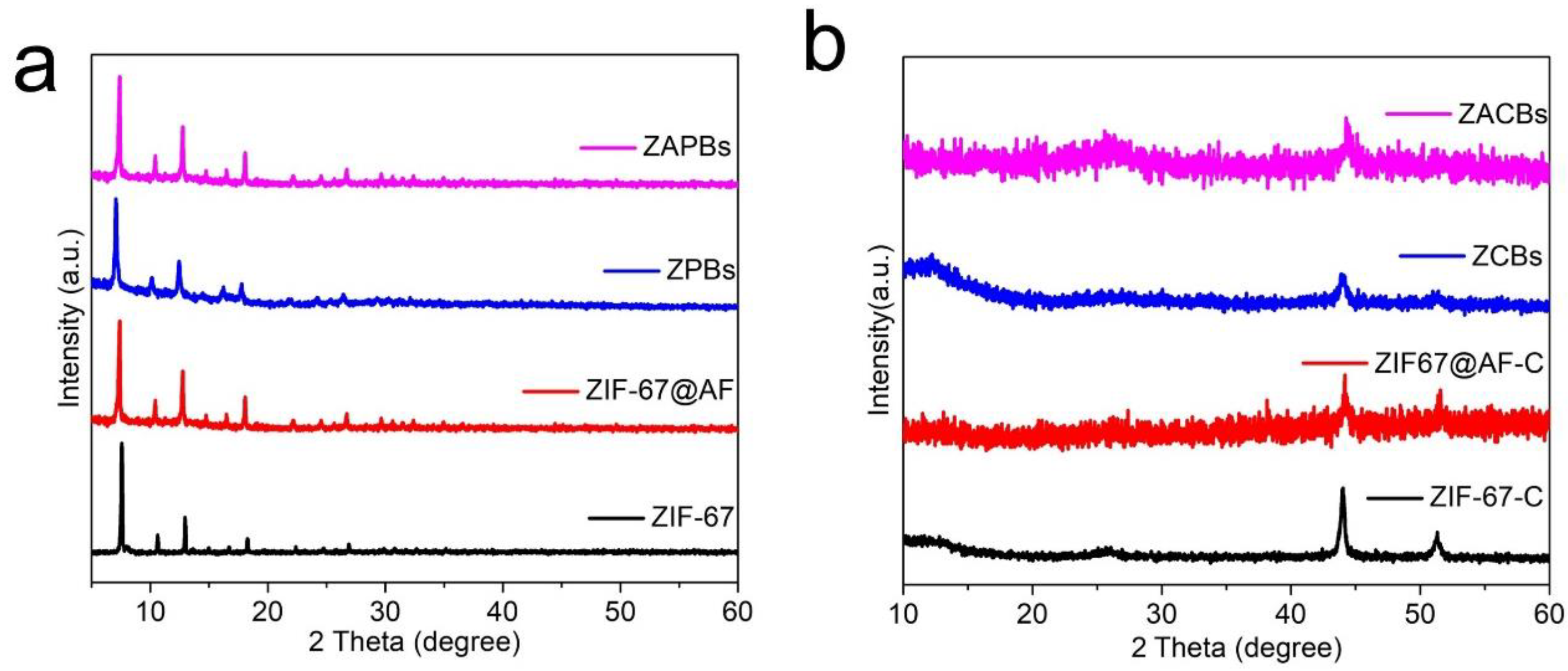
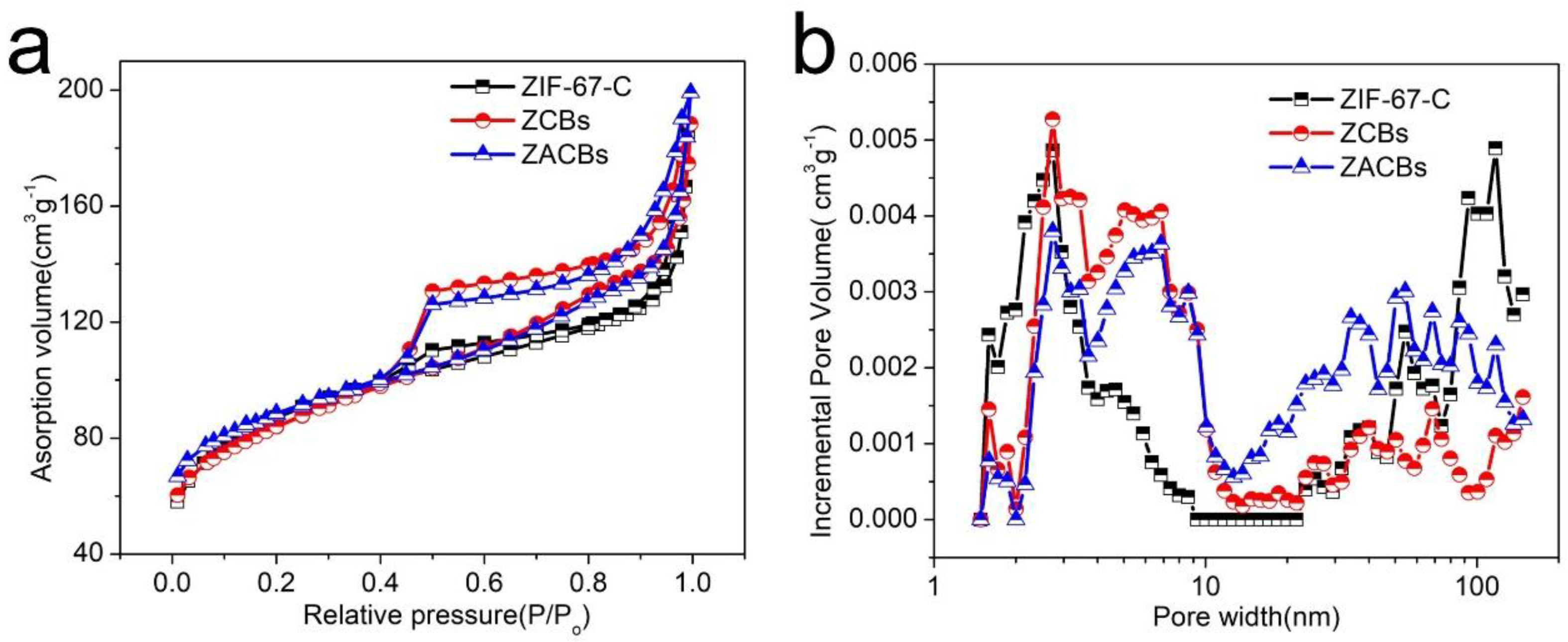
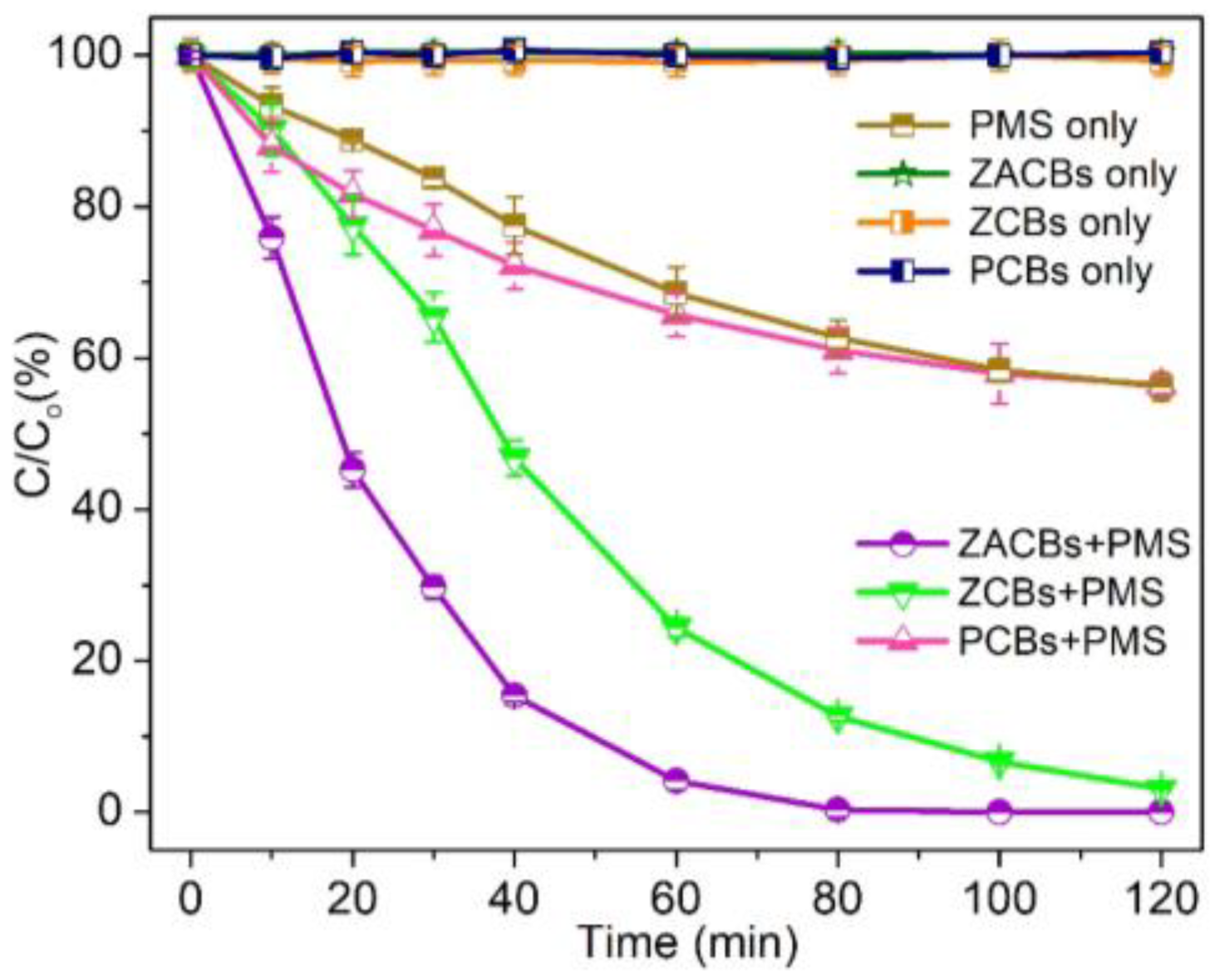
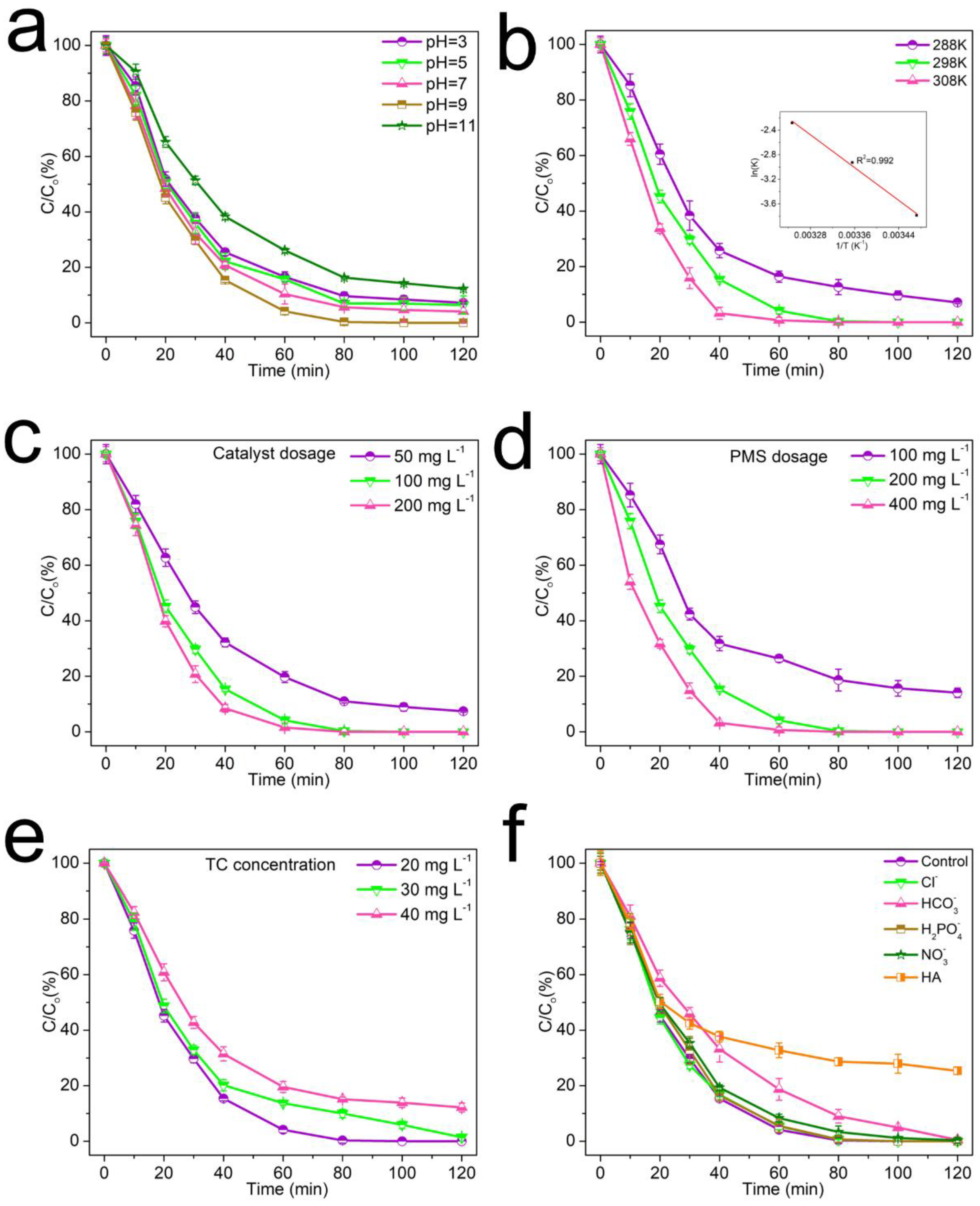
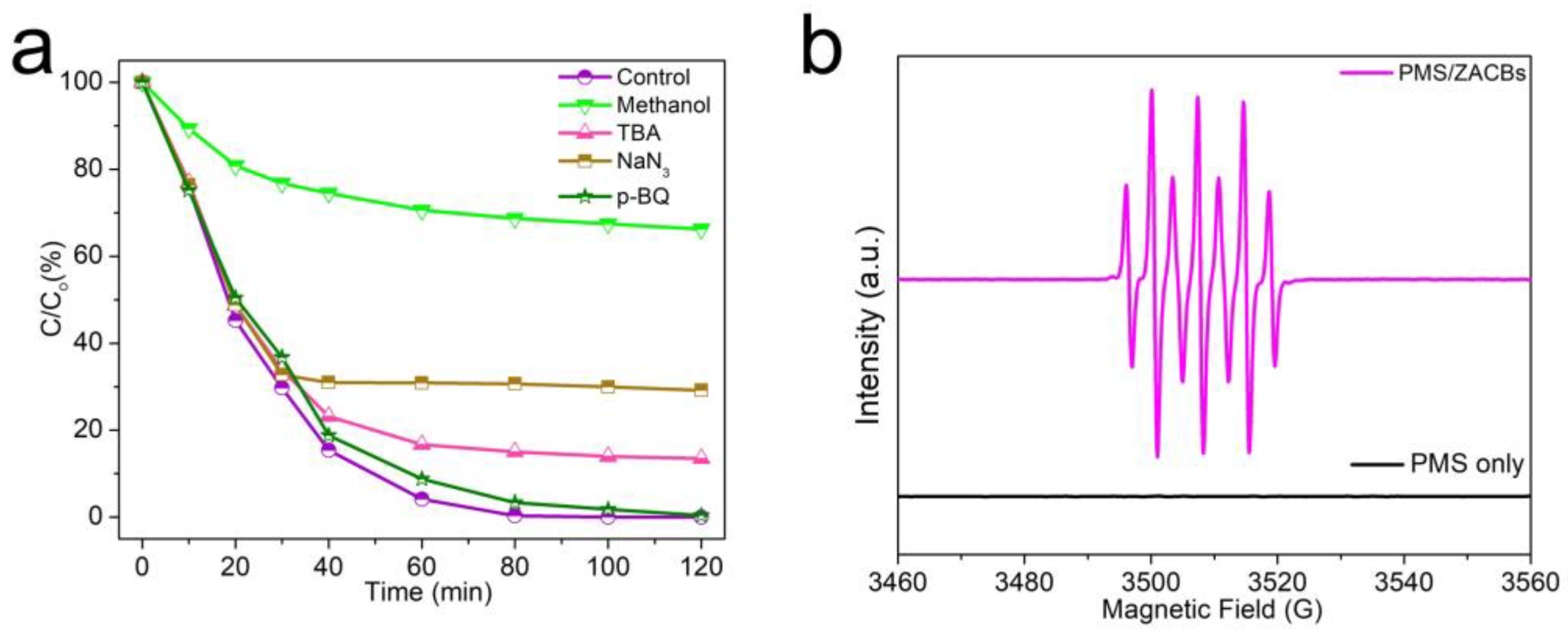

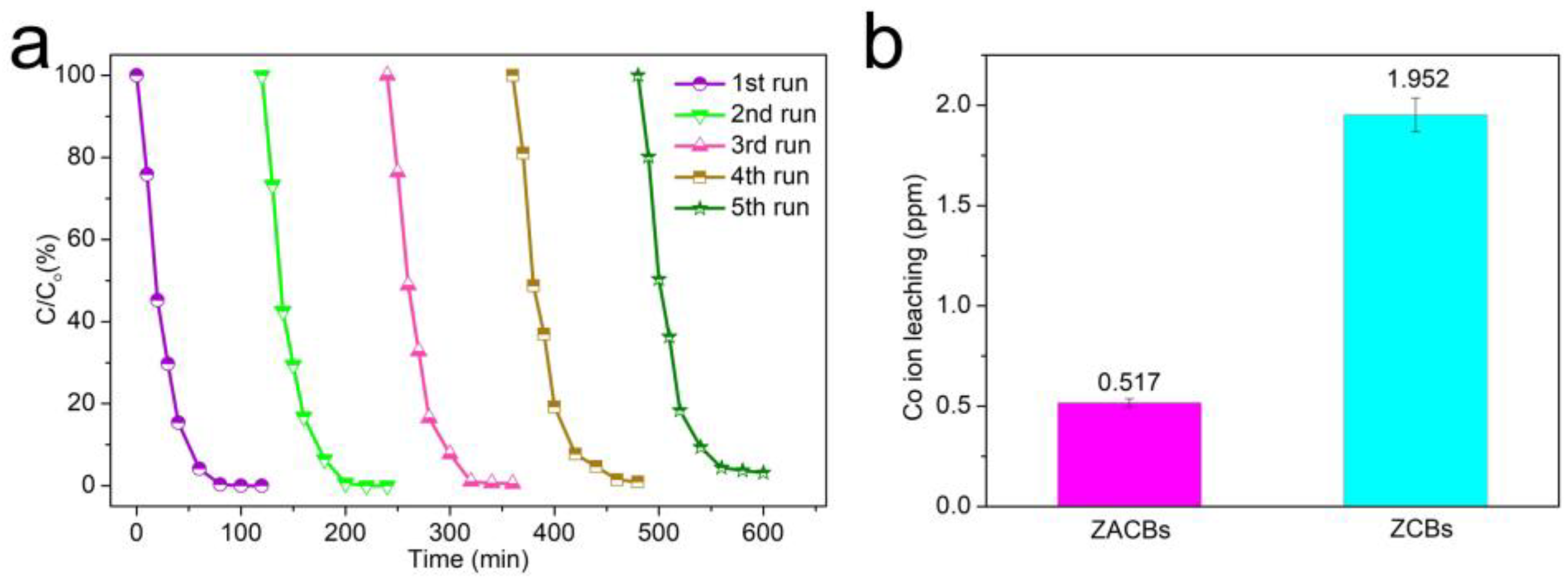
Disclaimer/Publisher’s Note: The statements, opinions and data contained in all publications are solely those of the individual author(s) and contributor(s) and not of MDPI and/or the editor(s). MDPI and/or the editor(s) disclaim responsibility for any injury to people or property resulting from any ideas, methods, instructions or products referred to in the content. |
© 2024 by the authors. Licensee MDPI, Basel, Switzerland. This article is an open access article distributed under the terms and conditions of the Creative Commons Attribution (CC BY) license (https://creativecommons.org/licenses/by/4.0/).
Share and Cite
Yan, X.; Yao, Y.; Xiao, C.; Zhang, H.; Xie, J.; Zhang, S.; Qi, J.; Zhu, Z.; Sun, X.; Li, J. Shaping Phenolic Resin-Coated ZIF-67 to Millimeter-Scale Co/N Carbon Beads for Efficient Peroxymonosulfate Activation. Molecules 2024, 29, 4059. https://doi.org/10.3390/molecules29174059
Yan X, Yao Y, Xiao C, Zhang H, Xie J, Zhang S, Qi J, Zhu Z, Sun X, Li J. Shaping Phenolic Resin-Coated ZIF-67 to Millimeter-Scale Co/N Carbon Beads for Efficient Peroxymonosulfate Activation. Molecules. 2024; 29(17):4059. https://doi.org/10.3390/molecules29174059
Chicago/Turabian StyleYan, Xin, Yiyuan Yao, Chengming Xiao, Hao Zhang, Jia Xie, Shuai Zhang, Junwen Qi, Zhigao Zhu, Xiuyun Sun, and Jiansheng Li. 2024. "Shaping Phenolic Resin-Coated ZIF-67 to Millimeter-Scale Co/N Carbon Beads for Efficient Peroxymonosulfate Activation" Molecules 29, no. 17: 4059. https://doi.org/10.3390/molecules29174059



